black walnut

Black walnut or black walnut (juglans nigra) is a type of walnut tree native to North America. At home, it is called black walnut. It is called black by no means because of the black color of the fruits or trunks, but because of the black powerful root system of the tree. It is also called the American walnut, as it naturally grows exclusively in the forests of North America.
Appearance
The black walnut tree as a whole looks the same as other walnut trees, however, there are some appearance features that are unique to this tree:
- The trunks of the tree are chocolate-brown in color, reaching a height of up to 50 meters.
- The wood is strong, but easy to process, which makes it a valuable material for the manufacture of various wooden objects. It is decorated with a beautiful and pleasant texture, due to which it is widely used in the manufacture of furniture and interior decoration.
- The crown is vaulted, very wide, lowered downwards. Its diameter is equal to the height of the tree, and can grow even more.
- The roots are black, covered with deep cracks. They grow very deep. Root system type: rod.
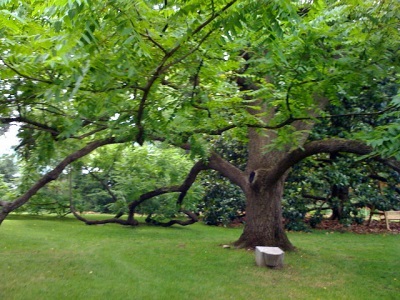
The leaves of the tree are pinnate, alternately arranged. They reach a length of up to 25-30 centimeters, often consist of 11-23 pieces of light green leaves.Leaflets are oval, slightly oblong with finely serrated edges. In length they reach 6-10 centimeters, in width no more than three. The venation is pinnate. Blooms in April and May.
The black walnut tree is a monoecious plant. Staminate flowers are collected in earrings, the length of which is from 5-15 centimeters, and pistillate flowers are 3-5 flowers in a brush. Trees bloom, starting from 7-10 years of age, in April and May.

The fruits of the black walnut are round, ovoid and obovate nuts, pointed at the top. In diameter it consists of 3-5 centimeters. They ripen in a peel with 5-10 millimeters of thickness. Inside the peel is a very strong four-celled shell.
Inside the shell are edible kernels. They have a specific smell. Resistant to oxidation from a special composition.

Kinds
The black walnut belongs to the genus Nut, the Nut family, the Bukotsvetny order, the Dicotyledonous class, the Flowering department and the Plant kingdom. In addition to it, this genus includes such types of nuts as:
- walnut;
- Californian;
- small-fruited;
- neotropical;
- ailantholist;
- Manchurian;
- gray, etc.






Where does it grow?
The black walnut is native to North America, where it grows from Massachusetts to Florida and Texas. They were brought to Russia in the middle of the 18th century. Today it is distributed throughout Europe, except for the countries of Scandinavia, where the climate is too cold for this plant. On our territory it grows in the regions of Krasnodar and Stavropol.
Grows:
- in deciduous forests;
- in the mountains with fertile and moist soil;
- off the coast of a reservoir;
- in the alleys, etc.

Method of collecting, processing and storing nuts
Harvesting of black walnut fruits is carried out in autumn.Today, various harvesting machines and equipment have been developed to facilitate the process of harvesting nuts.

In their absence, nuts can be harvested by hand. Ripe nuts fall by themselves. It is enough to collect them with your hands from the ground. To do this, first put on thick rubber gloves.
To speed up the process of falling nuts, you can hit the branches of the tree with sticks or other devices, however, it should be noted that this action can damage the branches and leaves of the tree. In addition, some branches are located so high that it is impossible to reach them. Nuts from high branches just need to wait.
After harvesting, the process of processing nuts begins. This step can also be done with the help of technique. Rubber gloves should be worn during manual processing, as the juice of the black walnut fruit leaves stains that are difficult to wash off.
The peel of ripe nuts changes from dark green to yellowish green. The skin can be removed with a small knife.
The second way: after crushing, remove the opened skin with your hands.
The third way: open nuts can be put in water, the peel will float away, but the nuts will remain. Then you need to lay out the brown nuts so that they dry. The drier the nuts are, the easier it will be to get nut kernels from them. In order to separate the kernels from the shell, you can use hammers, a vice and tongs.

It is easier to store nuts with shells. It is enough to put them in a resealable metal container or cotton bags and put them in a cool place protected from the sun. In this way, you can store nuts for more than 6 months.

Nut kernels should be kept in the refrigerator, and preferably in the freezer.To do this, put the nuts in a tightly closed dish (containers will do) or in plastic bags. Can also be wrapped in food foil.
To extend the shelf life of unpeeled and peeled nuts; in order to get rid of insects that spoil nuts, they can be calcined in an oven or on a stove.
The peeled kernels are heated in a frying pan. However, it must be remembered that during heat treatment, some useful properties are forever lost.
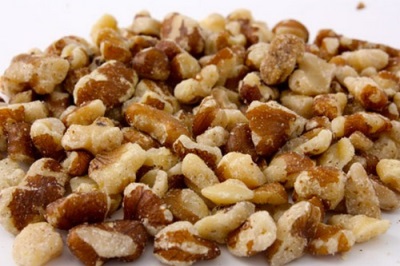
How to choose and where to buy
You can buy black nuts with or without shells. When buying inshell nuts, choose only nuts with clean, unstained or cracked shells. Darker-colored shells may be last year's, overdried, as a result of which they will be less tasty and will not be stored for long. Also, if a sound is heard when shaking, this means that the nuts are overdried.
When buying shelled nuts, if possible, it is best to taste and smell them. If you feel the taste and smell of rancid, it is better not to buy such nuts, most likely they have begun to deteriorate.
You can buy black nuts on the websites of online stores.

Characteristics
The black walnut tree has the following characteristics:
- This long-lived plant can live up to 70 years.
- Grows fast.
- It can survive both hot weather and short-term flooding.
- Able to survive in urban environments.
- It is a source of medium-heavy, hardwood, dark brown dyed and with a beautiful texture.
- Produces tasty and high-fat nuts.

Nutritional value and calories
100 grams of black walnut contains:
| Squirrels | Fats | Carbohydrates | calories |
| 24.06 gr. | 59 gr. | 3.11 gr. | 618 kcal |
Percentage B/W/U: 15%/83.1%/1.9%
Chemical composition
The composition of black walnut fruits is saturated with:
- flavonoids;
- jugladin alkaloid;
- polyphenolic substance - juglone;
- tannins, carotene;
- phytocides, glycosides;
- organic iodine;
- various vitamins (C, B1, B6, P, E, B, PP, provitamin A and vitamin F);
- essential oils;
- oleic, linolenic, palmentic, linoleic, lauric, myristic, arachidic and stearic acids;
- quinones;
- enzymes, sugar, as well as tannins and other substances.

Beneficial features
Due to its unique composition, black walnut fruits and leaves can be used as:
- blood-purifying and lymph-purifying;
- antispasmodic and vasodilating;
- sedative;
- absorbable, antitumor;
- anthelmintic and antitoxic;
- anti-infectious and antifungal;
- painkiller;
- anti-inflammatory and wound healing;
- tonic;
- antiemetic;
- rejuvenating;
- immunostimulatory agent;
- and also as an antioxidant.

Harm
- Excessive consumption of black nuts can be harmful. The optimal amount of nuts to eat is a handful of kernels per day.
- The abuse of nuts is especially harmful to children. Eating more than 10 pieces of these nuts by a child will lead to inflammation of the tonsils and spasm of the vessels of the head.
- Nuts are not good for people with allergies. They need to be very careful with nuts. An allergic reaction to this type of nuts can manifest itself in the form of sneezing, skin rashes may appear, pulmonary edema is caused, which is life-threatening.
- Instead of benefit, spoiled stale nuts can cause harm. They can lead to poisoning and diseases of the gastrointestinal tract.
- Eating moldy nuts can lead to dangerous cancers.
- Harmful and too overcooked nuts. They negatively affect the liver. In addition, as noted above, during heat treatment, some of the useful qualities of the products are lost.
- Caution in the use of nuts should be observed by people who are losing weight and overweight. Since black walnut is a high-calorie product, it should be consumed in a minimal amount or excluded from the diet.
Contraindications
Black nuts are contraindicated in people:
- with individual intolerance;
- with peptic ulcers;
- with cirrhosis of the liver;
- with thrombophlebitis;
- with gastritis;
- as well as pregnant and breastfeeding women.
Oil
From the fruits of the black walnut tree, black walnut oil is extracted by extraction. Such oil can be used in cooking, in medicine and in cosmetology.
Deodorized black walnut oil can be found in pharmacies. Inside they are used for:
- Prevention of acute respiratory viral infections, acute respiratory infections and influenza.
- Gastric and duodenal ulcers, intestinal dyspepsia, intestinal dysbacteriosis, chronic gastritis and colitis, immune system disorders.
- Eczema and other skin diseases (neurodermatitis, psoriasis, acne, allergic dermatitis, warts).
- Diabetes mellitus and thyroid dysfunction.
- Avitaminosis and rickets.
- Inflammation of the female genital organs and reproductive system.
- Pyelonephritis, cystitis, urethritis, parasitic infestations, herpes, skin tuberculosis.
- Acute conjunctivitis.
- Hemorrhoids, thrombophlebitis.

Other uses:
- Treatment of dry eczema, herpes, diathesis, psoriasis, herpes zoster. As well as abscesses and boils, fungal skin lesions, household and sunburn.For external use, rub the oil into problem areas of the skin 2-3 times a day.
- Rinse your mouth to get rid of abscesses and sores, in order to prevent periodontal disease.
- Steam inhalations are made with oil to treat colds. Inhalation and rinsing should be carried out with 2 teaspoons of oil per 250 ml of water.
- For oral administration, it is enough for adults to take half a teaspoon 3 times a day half an hour before meals, and for children from 3 years of age, take 10-15 drops also 3 times before meals. The course of treatment consists of one month.

Oil is contraindicated:
- People with high levels of iodine in the body.
- During pregnancy and lactation
Such oil can usually be stored for no more than 2 years in a place protected from sunlight at 25 degrees Celsius.
Tincture (Extract)
An extract is made from the skin of black walnut, which is an excellent anthelmintic agent.
Effectively affects only mature parasites and worms of intermediate forms of development. In addition, black walnut extract is antiseptic, anti-inflammatory, astringent and bactericidal. Effective in the destruction of some pathogenic fungi and bacteria.
Black walnut skin extracts, vegetable glycerin, and water are usually added to commercially available black walnut fruit extracts.
Recommended for:
- helminthiases;
- protozoal infections of acute and chronic forms;
- thrush;
- dysfunction of the digestive system;
- with complex programs for cleansing the body.

There are contraindications for individuals who have an individual intolerance to the components of the black walnut extract; pregnant and lactating women. Has an age limit.
Adults should take the extract inside 3 ml (approximately 75-80 drops) with 2 tablespoons of water. The course of treatment lasts from 2 to 3 weeks, is prescribed by a doctor. After taking the extracts, it is advised to take drugs that can kill the eggs and larvae of helminths.
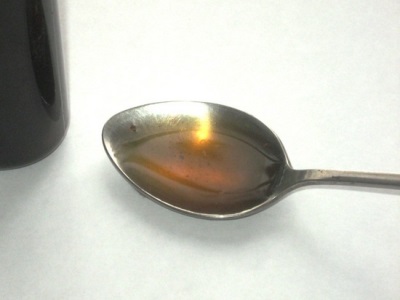
Juice
Juice is extracted from the pericarp of black walnut. This juice is used to stop bleeding and speed up the healing process of wounds.
Application
In cooking
Black walnut kernels can be eaten raw or cooked as part of dishes. With black walnut kernels, you can make jam, bake confectionery and make salads. Black walnut oil is added to various dishes.

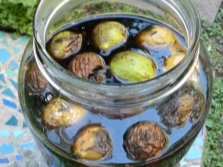

Black walnut jam recipe
The technology of cooking is similar to the technology of making walnut jam.
- For jam, young, unripe green nuts with a volume of about 100 pieces are taken. They are first cleaned, filled with water and soaked for a month. The water changes several times during the day.
- Nuts are pierced with a knife and filled with 0.5 kg. slaked lime and again filled with water.
- After 2 days, the nuts are thoroughly washed and again filled with water for 4 days. The water is also changed several times a day.
- After that, they are poured with boiling water, 1 tablespoon of alum is added and boiled for 20 minutes. The water is then drained and washed. Again, pour boiling water and cook for 7-10 minutes.
- After that, the nuts are thrown back into a colander and the syrup is boiled.
- For syrup, you need 2 kg of sugar. Sugar is poured with water, stirring, brought to a boil, nuts are added and boiled until the nuts turn black.
- You can put cloves, cinnamon and cardamom in the syrup.

In medicine
The composition of black walnut fruits, rich in useful substances, enables the human body to get rid of many ailments.
- Black walnut contains a large amount of iodine, which is so necessary for all people.
- Linolenic acid (omega 3) reduces the formation of low density cholesterol leading to atherosclerosis.
- The main active ingredient in black nuts, juglone acts as an antifungal, antibacterial, and anthelmintic agent. In addition, it improves the functioning of the gastrointestinal tract, reduces the occurrence of flatulence.
- Black Walnut quickly removes pathogens in fungal diseases.
- Flavonoids reduce the occurrence of vasospasm, thereby improving the functioning of the cardiovascular system.
- In general, black walnut has a beneficial effect on the body and strengthens the human immune system, thereby preventing colds and flu.
- In addition, it improves the process of metabolism and detoxification.

Thus, with the help of preparations based on black walnut, diseases such as:
- Stomatitis, periodontal disease and gingivitis.
- Inflammation of the food system.
- parasitic diseases.
- Irritation of the intestines.
- Candidiasis.
- Dysbacteriosis.
- Diseases of the reproductive system.
- Chronic eczema, dermatitis, boils and purulent wounds.
- Goiter, hypothyroidism and other thyroid diseases.
In addition, due to its medicinal properties, it is used in the treatment of the following diseases:
- Haemorrhoids.
- Oncological diseases.
- Migraine.
- Diabetes.
- Fungal diseases.
- Rheumatism, osteochondrosis, polyarthritis, arthrosis.
- Lymphadenitis.
- Diseases of the mammary gland.
- Sclerosis.
- Diseases of the liver.
- SARS, ARI.
- Worms.
- Early aging.
- Obesity, etc.
At home
- Black walnut kernels are used as a very tasty and fat-rich product.
- Many different wooden turning and carved products, musical instruments are produced from wood, they are used in the manufacture of furniture, interior decoration.
- On the basis of black walnut, therapeutic and prophylactic preparations are made.
- Jam is made with black nuts.



Varieties
Black walnut trees are applicable for the decoration of parks and gardens. For this purpose, more than a dozen varieties of this tree have been bred:
- varieties with thin shell nuts;
- walnut hybrid;
- Thomas black walnut;
- Wandersloot black walnut.
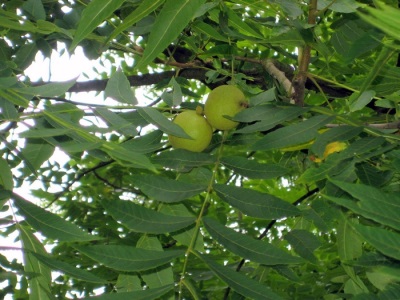
cultivation
The black walnut tree is an abundantly fruitful and at the same time decorative perennial plant. It tolerates winter well. Can be an excellent substitute for walnuts. For planting and growing a tree you need:
- Black walnut seeds.
- Large area about 15x15 m.
- Fertile, moderately moist soil.
- Long warm period.

Interesting Facts
- Even in ancient times, the properties of black walnut were known to the Indians. They treated them with many diseases, prolonging life and strengthening their health. Thanks to the miraculous qualities of black walnut extract, it has been called the elixir of life.
- It turns out that the roots of a black walnut in the first year of life grow three times more than its aerial part.
- Not many people know that black walnut contains 50 times more vitamin C than citrus fruits. And there are much more proteins and fats than in walnuts.
- The black walnut tree is very tall. To imagine its height, think of a 16-story building.



















Black nuts must be consumed in moderation, otherwise they may not rejuvenate, but harm.